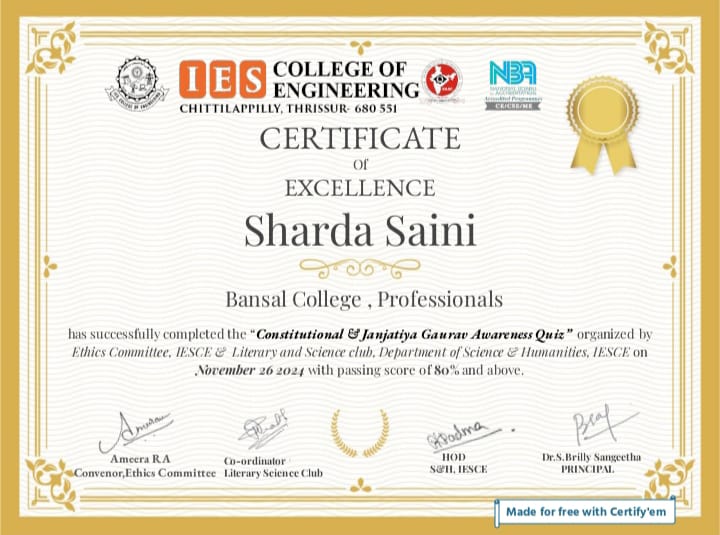
Organizer: The Literary & Science Club, Department of Science & Humanities in association with Ethics Committee, IES College of Engineering.
About the Quiz
- Online Quiz conducted CONSTITUTION DAY- JANJATIYA GAURAV DiVAS
- on 26th November,2024
- Open to Students & Professionals
- Free Participants & Limited Time.
- Meritorious Participants (80% in Quiz)will be awarded E- certificates.
Apply Link
100% Correct Answers Here
1) Which of the following statements best captures the significance of the Indian Constitution?
*
1 point
It serves as the supreme law of India, outlining the fundamental rights, duties, and principles that govern the nation.
It establishes a framework for a democratic, socialist, secular, and republic form of government in India.
It protects the rights and freedoms of Indian citizens, safeguarding them from arbitrary actions by the government.
It provides a roadmap for social, economic, and political development, striving to achieve justice, liberty, equality, and fraternity.
- How many schedules does the Indian Constitution have?*
1 point
10
12
8
11
3. The directive principles of state policy (DPSP) are adopted from the Constitution of which country?*
1 point
South America
Ireland
South Africa
Japan
4. Which is the highest law of Land?*
1 point
Indian Constitution
Penal code
Preamble
All of the Above
5. Who can alter the number of judges in the Supreme Court?*
1 point
President
Central Government
Supreme Court by Notification
Parliament by Law
6. How many types of emergency have been visualized in the Constitution of India?*
1 point
One
Two
Three
Four
7. What is the minimum age to contest elections of RajyaSabha?*
1 point
25 Years
30 Years
35 Years
21 Years
- Which of the following is a part of electoral college for the election of President but does not participate in the proceeding in his/her impeachment*
1 point
Lok Sabha
Rajya /sabha
State Legislative assemblies
State legislative councils - In the following which is not an emergency provision*
1 point
352
356
360
364 - What is the main difference between directive principles of state policy and fundamental rights*
1 point
Political protection
Moral protection
Judicial protection
Constitutional protection
11.ITDP refers to wgich one of the foloowing*
1 point
Integrated Tourism Development programme
Integrated Travel Development programme
Integrated Tribal Development programme
Integrated Transport Development programme
12 .The National Commission for Schedule Caste was established under……..of Indian Constitution.*
1 point
Article 338
Article 250
Article 180
Article 142
13. Which of the following is the constitutional body?
*
1 point
National Child Rights Protection Commission
National Backward Classes Commission
National Minorities Commission
National Commission for Scheduled Castes
14. In which part of the Indian Constitution, special provisions have been made for National Scheduled Castes and Scheduled Tribes, Other Backward Classes and Anglo Indians?*
1 point
Part XVI
Part XI
Part XXI
Part XIII
15. Which one of the following categories of Fundamental Rights incorporates protection against untouchability as a form of discrimination?*
1 point
Right against Exploitation
Right to Freedom
Right to Constitutional Remedies
Right to Equality
16. Who has the right to decide that who will be included in the list of Scheduled Caste and Scheduled Tribes?*
1 point
Parliament
President
Supreme Court
Governor of the state
17. Kaka Kalelkar Commission is related to………*
1 point
The National Commission for Scheduled Castes
The National Scheduled Tribes Commission
The backward class commission
The Anglo Indian community
18. What is the largest tribal community in India by population?*
1 point
Bhil
Gond
Santhal
Oraon
- Which ministry in India is responsible for tribal affairs? *
1 point
Ministry of Rural Development
Ministry of Tribal Affairs
Ministry of Social Justice and Empowerment
Ministry of Home Affairs
20. What is the purpose of the Forest Rights Act, 2006? *
1 point
Protect forest ecosystems
Grant rights to forest-dwelling communities
Encourage deforestation for industrial use
Penalize tribal communities for using forest resources